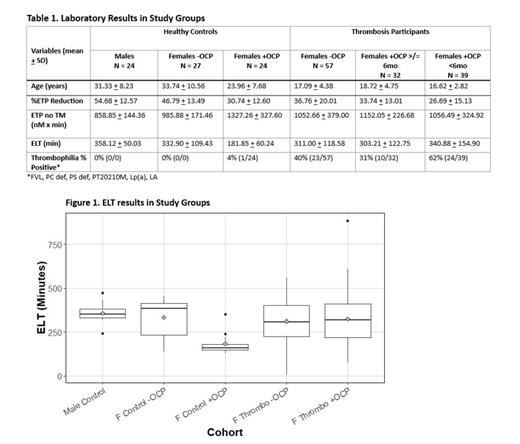Background: Estrogen-containing oral contraceptives (OCPs) increase the risk for thrombosis 3-4 fold in otherwise healthy young women, although the absolute thrombosis rate in young OCP users is only 0.05% per year (Trenor CC, Pediatrics. 2011;127: 347). In our prospective cohort database 70% of lower extremity venous thromboembolism in adolescent girls were associated with OCP use, usually of recent onset (<6months). OCPs are associated with acquired resistance to activated protein C (APC), an important thrombin regulatory pathway, with an increase in fibrinolysis (Douxfils J, Contraception, 2020;102:396). A causative role for estrogens in thrombus formation in young women is not completely understood.
Aims: This study evaluated thrombin generation, thrombin reduction by APC (activated protein C resistance, APCR), fibrinolysis and thrombophilia in healthy young males, healthy young females who were using or not using estrogen hormone therapy (i.e. oral contraceptive pills/OCPs) and young females with thrombosis who were using or not using OCPs at the time of thrombus presentation. The goal of this study was to measure the effects of OCPs on laboratory assays of coagulation and fibrinolysis to reveal potential mechanisms in increased thrombosis risk.
Methods: This was an analysis of a consented, prospective cohort study (Thrombo-PICS). Healthy controls included men and women with no personal or family history of bleeding or clotting who were using or not using OCPs and on no other relevant medications. Study groups included females who presented with thrombosis with no OCP use, or OCP use for less than six months versus six or more months. All participants with a history of thrombosis were studied three or more months following the onset of thrombosis and no longer on OCPs. Laboratory assays performed included calibrated automated thrombography (CAT) with and without thrombomodulin (CAT TM) to determine thrombin generation (endogenous thrombin potential, ETP) and thrombin reduction with APC (% ETP reduction, APCR) respectively, and the euglobulin clot lysis time (ELT) to model fibrinolysis. Factors known to cause APCR and to be associated with thrombosis were also assayed, including factor V Leiden (FVL), the prothrombin gene mutation (PTM), protein C, protein S, lipoprotein(a), and the lupus anticoagulant (LA). Overall results were presented using descriptive statistics. Chi-Squared tests and paired t-tests were used to make paired comparisons. Parametric and non-parametric paired comparisons were used to evaluate group differences in ETP, % ETP reduction, ELT and presence thrombophilic traits relative to estrogen use and history of thrombosis.
Results: Table 1 and Figure 1 display results. All groups of females with a history of thrombosis had decreased mean %ETP reduction compared to healthy females not on OCPs (p=0.02), with the lowest values occurring in females with thrombosis following less than six months of OCP use. There was also a lower prevalence of abnormal CAT TM values amongst healthy controls not on OCPs as compared to thrombosis patients not on OCPs (19 vs 51%, p=0.005).Healthy females on OCPs showed an increased ETP (p=0.002) and a marked reduction in ELT (p<0.001) as compared to all other groups. Females with a history of thrombosis, whether associated with OCPs or not, were similar to healthy females not using OCPs in regard to ETP and ELT. Furthermore, females who developed thrombosis on OCPs were more likely to have a thrombophilic trait than healthy controls on OCPs (48 vs 4%, p<0.001). Healthy men were found to have a greater %ETP reduction than healthy women (p=0.04), while having a lower ETP than healthy women (p=0.007). There were no differences in ELTs between healthy male and female controls (p=0.39).
Discussion: OCPs were associated with increased thrombin generation, increased APCR and accelerated fibrinolysis in healthy female controls. The lower ELT in healthy controls using OCPs suggests that increased fibrinolysis may partially balance acquired APCR from estrogen use. We were unable to test fibrinolysis in females on OCPs prior to the onset of thrombosis. Females with thrombosis onset within six months of starting OCPs showed the highest prevalence of thrombophilic traits known to cause APCR. These data suggest that the APCR effect of OCPs potentially augments the prothrombotic effect of underlying thrombophilias in the promotion of clinical thrombosis.
Disclosures
Neeves:NovoNordisk: Honoraria. Manco-Johnson:Bayer: Honoraria; Spark: Honoraria; Novo: Honoraria; CSL Behring: Honoraria; Genentech: Honoraria.


This feature is available to Subscribers Only
Sign In or Create an Account Close Modal